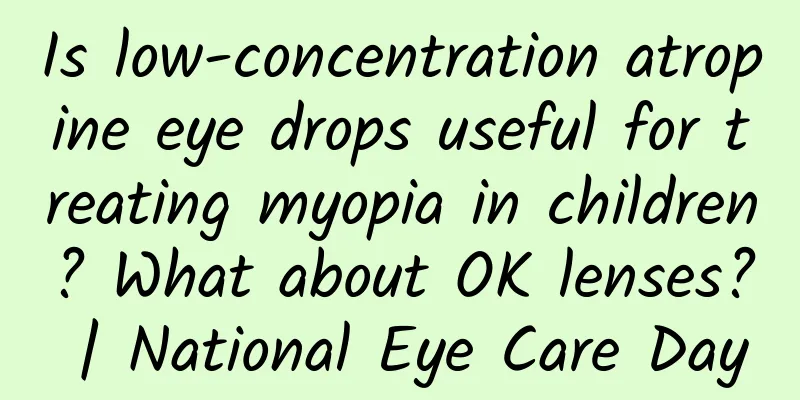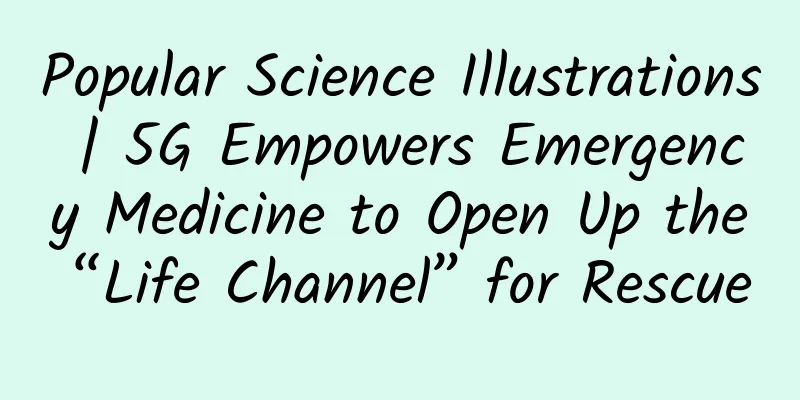Is low-concentration atropine eye drops useful for treating myopia in children? What about OK lenses? | National Eye Care Day

|
According to statistics from the National Health Commission, the myopia rate among children and adolescents (6-18 years old) nationwide exceeded 65% in 2019. After unremitting efforts by multiple departments to prevent and control myopia among children and adolescents, this proportion fell back to 53.6% in 2022. But at the same time, myopia is getting worse at a younger age, and many parents hope to intervene in their children's myopia as early as possible to prevent the deterioration of myopia. Along with this demand, there are a variety of "prevention and treatment" myopia products on the market. So, which ones are safe and effective? This article discusses atropine and OK lenses, two of the most common clinical methods for controlling myopia in children. On June 6, the National Eye Care Day, Fanpu reprints this article in the hope that it will be helpful to readers. By David Travis (Source: Unsplash) Written by Shui Yingbo (Department of Ophthalmology and Visual Sciences, University of Washington School of Medicine, USA, Doctor of Medicine) This article focuses on the use of low-concentration atropine eye drops to reduce/delay the progression of myopia in children. Note that it is to delay the progression of myopia in children (Reduce Myopia Progression), not to cure myopia (Cure Myopia). Myopia in children is a major concern and anxiety for parents. According to 2020 data from the National Health Commission's Disease Control Bureau [1], the overall myopia rate among Chinese children and adolescents is as high as 52.7%. In fact, China is not the country with the most serious myopia incidence. Singapore ranks first. According to the Singapore government's health department [2], the myopia rate among children in Singapore is as high as 65%, and the myopia rate among young people is even as high as 83%. Preventing myopia and slowing the progression of myopia is not only a top priority for parents, but also a major concern for health departments in countries around the world, especially in Southeast Asian countries where myopia among children is high. Myopia is a common vision disorder. The typical symptom is that patients can see things close up clearly, but things far away are blurry. This is because after parallel light rays are refracted through the eye's refractive system, the image is focused in front of the retina, rather than directly on the retina. The cause of myopia is mostly due to the excessive length of the anterior-posterior axis of the eyeball. When a baby is just born, the anterior-posterior axis of the eyeball is short, and the baby is generally in a state of hyperopia. Later, as the body develops, the eyeball also grows, that is, the eye axis gradually increases, and the hyperopia decreases. This process from higher hyperopia → lower hyperopia → emmetropia is also called the emmetropization process of eyeball development (Emmetropinization). If this process occurs too early and too quickly, the eyeball grows rapidly, resulting in an excessively long eye axis and the image cannot be focused on the retina, which develops into myopia. Myopia will deepen year by year during the growth stage of children. The causes of myopia are very complex, and are caused by a combination of factors such as heredity, development, nutrition, environment, and eye habits. Some factors are beyond our ability to overcome, such as heredity; some factors can be improved through acquired efforts, such as obtaining a balanced diet, engaging in adequate outdoor activities, and using eyes scientifically. A healthy lifestyle and the correct way of using eyes can prevent myopia and slow down its progression to a certain extent. Current studies have shown that the effect of simply relying on drugs to prevent and treat myopia is limited, so we should not have too high expectations for atropine eye drops, let alone regard them as a panacea for myopia. Atropine eye drops are considered an antique drug in the ophthalmology field. They are a non-selective muscarinic antagonist used to paralyze the ciliary muscles of the eye. They are clinically used for keratitis, iridocyclitis, before and after cataract surgery, and mydriasis refraction. Since 1989, when doctors in Taiwan first reported the results of a randomized controlled trial using 1% atropine to control myopia [3], atropine eye drops have been widely studied for preventing the deterioration of myopia in children. Of course, the results of related studies are varied, with some saying they are effective and others saying they are useless. In addition, some media irresponsibly either tout it as a "miracle drug" or criticize it as worthless, leaving parents at a loss as to who to trust. Author's drawing Believe in science and let the facts speak for themselves! Singapore is at the forefront of the world in research on low-concentration atropine to control myopia. The National Eye Research Institute of Singapore has conducted a large number of clinical studies on children. Since 2006, it has reported a large-scale randomized, double-blind clinical study on atropine for the treatment of myopia in children, as well as follow-up studies including myopia rebound after drug withdrawal. After comparing the efficacy and safety of atropine eye drops of different concentrations (1.0%, 0.5%, 0.1% and 0.01%), they found that 0.01% atropine has the best therapeutic index for Singaporean children, with relatively mild side effects. These research results were published in the world's top ophthalmology journals that have been rigorously reviewed by peers. [4-8] However, the focus of this article is on the latest report of the Low-Concentration Atropine for Myopia Prevention and Treatment (LAMP) study by the Department of Ophthalmology of the Chinese University of Hong Kong, because their research subjects are Chinese children. From 2019 to 2022, the Chinese University of Hong Kong published five high-quality papers with detailed content in the ophthalmology journal Ophthalmology. The main content is as follows: 1. First year study: 438 children aged 4 to 12 years with myopia of at least 100 degrees (-1.0D) were recruited and treated with 0.05%, 0.025%, and 0.01% atropine eye drops. The results showed that 0.05% atropine was the most effective in controlling myopia progression and delaying axial length (AL) growth within 1 year. [9] 2. Second year study: 383 children continued to participate in the study. The results showed that 0.05% atropine was twice as effective as 0.01% atropine in slowing myopia progression. Compared with other concentrations of atropine eye drops (0.025% and 0.01%), 0.05% was the best concentration for slowing myopia progression. [10] Note: The Singapore study recommended 0.01% atropine eye drops, which is different from the results of the Hong Kong study. 3. Third year study: 326 children continued to use atropine eye drops for treatment. It was found that all different concentrations of atropine eye drops achieved good results. Among them, 0.05% atropine still led the way in the treatment effect of children over a three-year period, and the myopia rebound rate was very low. [11] 4. Studies have found that the mechanism of action of low-concentration atropine in combating myopia is mainly to reduce the elongation of the axial length (AL), thereby reducing the risk of subsequent myopic complications; atropine eye drops do not change the refractive power of the cornea or lens. [12] 5. Continuous follow-up studies have found a pattern: the younger the age at which myopia begins, the higher the concentration of atropine required for treatment, that is, 0.05% atropine is more effective than 0.025% and 0.01%. Older children can achieve similar effects to 0.05% atropine eye drops in younger children using lower concentrations (0.025% and 0.01%). The main reason may be that myopia progresses faster at younger ages, so the intensity of medication needs to be moderately increased. [13] 6. Each of the above studies reported side effects of using atropine eye drops, the most important of which are ① photophobia, some children need to wear sunglasses when outdoors in the sun. ② poor eyesight, children complain that they can't see the words on the book clearly and need to hold it farther away to read. ③ allergic conjunctivitis. Most children can tolerate these side effects, and a few who can't tolerate them have to stop taking the drug. Side effects can be eliminated quickly after stopping the drug. In addition, clinical studies on low-concentration atropine are also being conducted in full swing in mainland China. The interim results of some studies have been published [14-15]. The results have once again confirmed that low-concentration atropine eye drops are effective in preventing the progression of myopia. We look forward to more studies being published in the near future. After comparing and cross-referencing a large amount of independent clinical research data from countries around the world, the ophthalmology community has reached a relatively unified opinion: low-concentration atropine eye drops have a certain definite effect in delaying children's myopia and axial growth, but they are not a "magic drug" that can cure myopia. It should be noted that the progress of various governments in approving low-concentration atropine for myopia in children varies. The Singapore Health Authority (HSA) has approved 0.01% atropine for legal use in children aged 6 to 12 years old with a doctor's prescription to slow the progression of myopia. China's National Medical Products Administration (NMPA) and the US Food and Drug Administration (FDA) have not yet officially approved low-concentration atropine eye drops for delaying myopia in children, and only allow clinical research on the drug for myopia in children. This may be one of the reasons why it is not easy to obtain low-concentration atropine eye drops in China. With the completion of the Phase III clinical study report, I believe this dilemma will be gradually resolved in the near future. In addition to simply using low-concentration atropine to prevent and treat myopia in children, the ophthalmology community is currently conducting some combined treatment clinical studies. For example, low-concentration atropine combined with orthokeratology (Ortho-K, OK lenses) [16-19], binocular visual function (BVF) balance training combined with virtual reality (VR) [20], and soft contact lenses designed with peripheral defocus double concentric circles [21]. Currently, research on myopia prevention and treatment is changing with each passing day, and whether new methods are effective is still under exploration. This article cannot list them one by one. Here we only focus on the research progress of low-concentration atropine combined with orthokeratology (Ortho-K, OK lenses). OK lenses are specially designed, reverse-geometry, gas-permeable contact lenses that are used to temporarily change and reshape the corneal surface curvature to correct refractive errors. Wearing OK lenses at night flattens the central cornea to reduce daytime myopia, with obvious short-term effects. Since the cornea will return to its original state (rebound) after stopping wearing the lenses, it is necessary to wear the lenses for a long time to achieve the effect of correcting refraction. In 2004, the FDA approved OK lenses for nighttime wear by adults. Although this approval did not include children, the FDA allowed ophthalmologists to use OK lenses at their discretion in children. Once this opening was opened, in recent years, more and more people have used OK lenses alone or in combination with low-concentration atropine for the prevention and treatment of myopia in children. A comprehensive analysis by Taiwanese scholars [16] compared in detail the studies on orthokeratology (Ortho-K, OK lenses), atropine eye drops, and the combined use of atropine and OK lenses in recent years. The results showed that: 1) In 19 independent randomized controlled trials with good quality (including a total of 3435 patients), atropine (0.01%~1%) can significantly slow the progression of myopia, and the dose is proportional to the effect, that is, the higher the concentration, the more obvious the effect. This is consistent with our known research results. 2) Extremely low concentrations of atropine (0.01%) combined with OK lenses have a certain synergistic effect, and the therapeutic effect is equivalent to that of large doses of atropine alone. 3) There are many problems with using OK lenses alone. For example, the sample size of many studies is too small. Safety issues such as corneal damage in children lead to a high dropout rate among children participating in the study. In addition, there is a lack of follow-up after discontinuation of use and cost issues. The results of the studies are inconsistent. Some are reported to be effective, but it is difficult to determine the effectiveness of OK lenses in others. The conclusion of the 2019 special report of the American Academy of Ophthalmology is [19]: The use of orthokeratology (Ortho-K, OK lenses) to prevent the progression of myopia in children may slow the progression of myopia in children and adolescents. However, since contact lens wear may increase the risk of keratitis caused by blinding microorganisms, safety remains a major issue. In other words, there are both benefits and risks, and how to choose is a matter of opinion. In general, the ophthalmology community is more confident about the use of low-concentration atropine in children, but is more cautious about OK lenses. At this point, you may find that, apart from low-concentration atropine eye drops, this article does not introduce any other products that delay the progression of myopia. Frankly speaking, there are too few reliable products for preventing myopia, and doctors are also helpless. With the innovative development of science, perhaps some other effective products for preventing myopia will be born in the near future. However, before seeing the formal research report after strict peer review, I will not recommend some of the so-called myopia treatment devices on the market, nor dare to recommend them! I hope that colleagues in the industry will be based on science and not irresponsibly recommend or promote some high-priced and uncertain efficacy products, or even immature products that are only under research, to parents for economic benefits. Writing this paragraph may offend some people or companies. Please be patient, and you are welcome to come up with solid research results - not advertising slogans - to convince me and my colleagues in the ophthalmology field. It is hoped that through the joint efforts of researchers from all countries, ophthalmologists will have more and better ways to help children overcome the problem of myopia and give children a future where they can see clearly. Once again, The National Health and Family Planning Commission and six other departments jointly issued a document to clarify that misleading statements such as "myopia is cured" should not be promoted during myopia correction. Myopia can be corrected, prevented, controlled and alleviated, but it cannot be cured under current medical technology conditions. References [1] In 2020, the overall myopia rate among children and adolescents in my country was 52.7%, and the problem of myopia at a younger age remains prominent. Source: Xinhua News Agency. 2021-07-13 20:07 http://www.gov.cn/xinwen/2021-07/13/content_5624709.htm [2] Speech by Dr Lam Pin Min, Senior Minister of State for Health, Singapore, at the opening ceremony of the Myopia Centre at the Singapore National Eye Centre. 2019-08-16. https://www.moh.gov.sg/news-highlights/details/speech-by-dr-lam-pin-min-senior-minister-of-state-for-health-at-the-opening-of-the-singapore-national-eye-centre-s-myopia-centre-16-august-2019 [3] Yen MY, Liu JH, Kao SC, Shiao CH. Comparison of the effect of atropine and cyclopentolate on myopia. Ann Ophthalmol. 1989;21(5):180-182, 187. [4] Chua WH, Balakrishnan V, Chan YH, Tong L, Ling Y, Quah BL, Tan D. Atropine for the treatment of childhood myopia. Ophthalmology. 2006 Dec;113(12):2285-91. [5] Tong L, Huang XL, Koh AL, Zhang X, Tan DT, Chua WH. Atropine for the treatment of childhood myopia: effect on myopia progression after cessation of atropine. Ophthalmology. 2009 Mar;116(3):572-9. [6] Chia A, Chua WH, Cheung YB, Wong WL, Lingham A, Fong A, Tan D. Atropine for the treatment of childhood myopia: safety and efficacy of 0.5%, 0.1%, and 0.01% doses (Atropine for the Treatment of Myopia 2). Ophthalmology. 2012 Feb;119(2):347-54. [7] Chia A, Lu QS, Tan D. Five-Year Clinical Trial on Atropine for the Treatment of Myopia 2: Myopia Control with Atropine 0.01% Eyedrops. Ophthalmology. 2016 Feb;123(2):391-399. [8] Chia A, Chua WH, Wen L, Fong A, Goon YY, Tan D. Atropine for the treatment of childhood myopia: changes after stopping atropine 0.01%, 0.1% and 0.5%. Am J Ophthalmol. 2014 Feb;157(2):451-457. [9] Yam JC, Jiang Y, Tang SM, et al. Low-Concentration Atropine for Myopia Progression (LAMP) Study: A Randomized, Double-Blinded, Placebo-Controlled Trial of 0.05%, 0.025%, and 0.01% Atropine Eye Drops in Myopia Control. Ophthalmology. 2019;126(1):113-124. [10] Yam JC, Li FF, Zhang X, et al. Two-Year Clinical Trial of the Low-Concentration Atropine for Myopia Progression (LAMP) Study: Phase 2 Report. Ophthalmology. 2020;127(7):910-919. [11] Yam JC, Zhang XJ, Zhang Y, et al. Three-Year Clinical Trial of Low-Concentration Atropine for Myopia Progression (LAMP) Study: Continued Versus Washout: Phase 3 Report. Ophthalmology. 2022;129(3):308-321. [12] Li FF, Kam KW, Zhang Y, et al. Differential Effects on Ocular Biometrics by 0.05%, 0.025%, and 0.01% Atropine: Low-Concentration Atropine for Myopia Progression Study. Ophthalmology. 2020;127(12):1603-1611. [13] Li FF, Zhang Y, Zhang [14] Wei S, Li SM, An W, Du J, Liang X, Sun Y, Zhang D, Tian J, Wang N. Safety and Efficacy of Low-Dose Atropine Eyedrops for the Treatment of Myopia Progression in Chinese Children: A Randomized Clinical Trial. JAMA Ophthalmol. 2020 Nov 1;138(11):1178-1184. [15] Wei S, Li SM, An W, Du J, Liang X, Sun Y, Gan J, Bai W, Tian J, Cai Z, Yin L, Wang N. Myopia progression after cessation of low-dose atropine eyedrops treatment: A two-year randomized, double-masked, placebo-controlled, cross-over trial. Acta Ophthalmol. 2022 Aug 23. doi: 10.1111/aos.15235. Online ahead of print. [16] Tsai HR, Wang JH, Huang HK, Chen TL, Chen PW, Chiu CJ. Efficacy of atropine, orthokeratology, and combined atropine with orthokeratology for childhood myopia: A systematic review and network meta-analysis. J Formos Med Assoc. 2022. [17] Chen Z, Huang S, Zhou J, Xiaomei Q, Zhou X, Xue F. Adjunctive effect of orthokeratology and low dose atropine on axial elongation in fast-progressing myopic children-A preliminary retrospective study. Cont Lens Anterior Eye. 2019 Aug;42(4):439-442. [18] Sánchez-González JM, De-Hita-Cantalejo C, Baustita-Llamas MJ, Sánchez-González MC, Capote-Puente R. The Combined Effect of Low-dose Atropine with Orthokeratology in Pediatric Myopia Control: Review of the Current Treatment Status for Myopia. J Clin Med. 2020 Jul 24;9(8):2371. [19] VanderVeen DK, Kraker RT, Pineles SL, et al. Use of Orthokeratology for the Prevention of Myopic Progression in Children: A Report by the American Academy of Ophthalmology. Ophthalmology. 2019;126(4):623-636. [20] Yuping Shi, Effect of Atropine Eye Drops Combined with VR-Based Binocular Visual Function Balance Training for Prevention and Control of Juvenile Myopia. Evidence-Based Complementary and Alternative Medicine Volume 2022, Article ID 4159996, 6 pages https://doi.org/10.1155/2022/4159996 [21] Erdinest N, London N, Levinger N, Morad Y. Myopia Control with Combination Low-Dose Atropine and Peripheral Defocus Soft Contact Lenses: A Case Series. Case Rep Ophthalmol. 2021 Jun 14;12(2):548-554. This article was originally published on Shui Yingbo Science Network Blog ( Produced by: Science Popularization China Special Tips 1. Go to the "Featured Column" at the bottom of the menu of the "Fanpu" WeChat public account to read a series of popular science articles on different topics. 2. Fanpu provides a function to search articles by month. Follow the official account and reply with the four-digit year + month, such as "1903", to get the article index for March 2019, and so on. Copyright statement: Individuals are welcome to forward this article, but any form of media or organization is not allowed to reprint or excerpt it without authorization. |
Recommend
How do designers work with engineers to create UI animations?
Today, designer @Akane_Lee and an engineer share ...
Fan Gongzi's "White, Rich and Beautiful Girlfriend Plan" is the unprecedented and only strategy to attract white, rich and beautiful women
Course Catalog of Fan Gongzi's "White, R...
Analysis of the "Standing Broom" Marketing Screen-Sweeping Event!
In the past few days, a "performance art&quo...
Pattern matching in Swift
[[156836]] One of Swift's great features is t...
Case analysis: How to operate an event?
Do you know how other people’s “phenomenal activi...
Are you feeling overwhelmed by life? These 4 methods will help you get back to your normal state!
...
In the first month of the new year, what wonderful shows will be performed on the starry sky stage?
2024 is here. What wonderful shows will be staged...
Best Practices for Customizing Android BaseAdapter
Although many new projects are using RecyclerView...
Is Lancome's weight loss product really effective? How effective are Lancome's weight loss pills?
Lancome weight loss digestive system irritation L...
High temperature can kill bacteria, so can spoiled food still be eaten after boiling?
Author: Mei Xue, Chief Physician of the Emergency...
As long as charging stations are popularized, will 300 kilometers of driving range of electric vehicles be enough? We find this is unrealistic!
The statement made by Xu Heyi, chairman of BAIC M...
How to design a B-side button? Check out this expert summary!
In the B-side interface, buttons are the most bas...
Who is painting the pie and who is sowing the seeds on the eve of China's auto market transformation
The biennial Shanghai International Auto Show is ...
Let’s put it in simple terms, the metaverse is coming towards us whether we like it or not. So is it a wolf or a sheep?
"Suddenly, as if overnight, a spring breeze ...








![[2014 WOT Shenzhen Station Lecturer Interview] Huo Dianyan: New technology is the core value of mobile games](/upload/images/67ebf1f9dd40a.webp)
